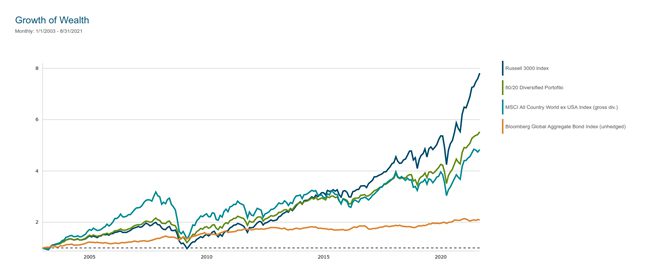By Joel Musser, CFP
So, you followed the advice of your Financial Planner and have been putting away $200 per month for your child’s college education fund since he/she was born 18 years ago in 2003. You had been scared by the college inflation rate which, at 8% on average, means that the cost of college would double every 9 years– twice before freshman year of college! The goal was to make sure you were able to help fund undergraduate education and not have to pay out of pocket for the entire cost.
Fast forward 18 years to today and markets have performed wonderfully over the last 2 decades. A dollar invested in a diversified portfolio of 80% stocks/20 bonds has grown to almost $6!
In real terms, that 80/20 college portfolio with $200 per month of contributions has grown to a whopping $115,000 today, which is good news, but comes with an interesting dilemma…
According to the College Board data, between 2010 – 2020, total tuition, fees, room and board expenses out-paced inflation by only 1.8% per year at public and private four-year institutions – significantly less than the previous decades of cost increases. Add in your child’s desire to go to an in-state school, stay at home for a couple years, or get more scholarship money than expected, and you may find yourself with an overfunded education account.
So, what are the options to get the money back out most efficiently?
- Pay for all eligible costs directly from the college savings account (529 plan or ESA). This will prevent you from having to explain the distribution to the IRS altogether.
- Make a distribution equal to the scholarship money received each year. The beneficiary will owe taxes on the pro-rata growth of the fund, but no penalty.
- Change the account beneficiary. If the funds are held in a 529 plan, you can allow them to continue to grow tax-free and earmark the funds for use at a later time (post-graduate expenses, college for grandkids, etc). You can even use the funds for yourself if you decide to go back to school. In the case of an Education Savings Account (ESA), you will have to roll over the funds to a 529 account in order to avoid the ESA “distribution by age 30” rule.
- Calculate the estimated surplus and make a small distribution for non-qualified expenses each year. Since the distributions are not for education costs, your beneficiary will have to pay taxes on the pro-rata growth of the account, plus a 10% penalty. Since the college student is likely at a lower tax bracket, however, by spreading these distributions over a number of years, it will likely reduce the tax liability.
At Total Wealth Planning, we help clients navigate through all of life’s financial questions including how to prepare for and achieve the college funding goals of our clients. If you or someone you know could benefit from some advice about how to save for college, pay for college, or distribute college funds in an efficient manner we would be more than happy to have a conversation.








